|
Editorial Note: In January, 2011, Jack Isaacson celebrates his 50th anniversary of living with diabetes while on insulin. Jack has the original diabetes educational materials produced by Diabetes Center of Excellence, which he was given in 1961. I met Jack in 1962 in the summer after my freshman year in college. We have been friends since. His life story is remarkable. Jack's note was in response to this week's column about SETMA's Diabetes Prevention Program; he said:
"This is a long way from how I found I was a diabetic in January 1961. Actual I
had it in the fall of '60 but didn't know it. This is excellent work and I hope your
staff understands how their work can made life better for those people who find
out they are diabetics through this screening process and before the disease can
do great harm to the person with this disease. Jack"
Jack is also an excellent editor and found several errors in my manuscript. His admonition is poignant and worthy of our remembering every day as we see patients.
Diabetes Center of Excellence
Six SETMA providers have just returned from the semi-annual orientation for new Affiliates of Joslin Diabetes Center held at the Joslin headquarters in Boston, Massachusetts, where Joslin is affiliated with Harvard School of Medicine. As each of us walked through the halls of Joslin, we were surrounded by murals and memorabilia of Dr. Elliott Joslin who founded the clinic in 1898. Dr. Joslin treated patients with diabetes before there were any tools and when the life-expectancy of a person with Type 1 diabetes was measured in months rather than a lifetime.
It was impossible to visit Joslin without being challenged by the commitment, compassion and courage of Dr. Joslin's life and work. In the ensuing 112 years, Joslin has grown into the world's premier treatment and research center for all types of the disease. SETMA is proud to be invited to be affiliated with Joslin.
In that SETMA is the first Joslin affiliate which is dominated by primary care physicians and nurse practitioners, a program has been devised whereby all SETMA primary care providers can work toward being designated as Certified Joslin Primary Care Providers upon completion of a rigorous course of study and testing. The first step of this program is the reading of ten Joslin monographs and the successful completion of ten tests on that material.
All SETMA primary care providers have completed the monographs and the testing. Also, all of SETMA's specialist (Endocrinology, Cardiology, Neurology, Ophthalmology, Infectious Disease and Pediatrics) have completed the testing. The benefit of all SETMA providers including specialists completing this continuous medical education program is that now every provider who will see any patient at SETMA and/or at the Diabetes Center of Excellence Affiliate at Southeast Texas Medical Associate will do so with a common fund of knowledge about diabetes, AND with a common sensitivity to the standards of care of diabetes, the nature and potential complications of the disease and with an understanding of best practices concerning treatment methodologies.
The key dates in SETMA's affiliation with Joslin are:
- January, 2003, SETMA's first presentation to Joslin of our Diabetes Program
- January, 2008, Joslin's staff's first visit to SETMA
- July 28, 2010, SETMA is officially accepted as an affiliate
- August 12, 2010, Joslin sends SETMA the monographs for first part of the Certified Joslin Primary Care Provider program
- August 17, 2010, SETMA distributes notebooks with the ten monographs
- August 23, 2010, SETMA announces the Affiliation on our website
- September 7, 2010, SETMA receives the password where the tests for the ten monographs can be taken.
- September 25, 2010, all SETMA providers complete the testing
SETMA is confident that our affiliation with Joslin Diabetes Center will result in even better care for patients with diabetes than they have been receiving. We are also confident that the presence of Joslin's influence will have a positive affect upon diabetes care in the Golden Triangle.
Diabetes Prevention Program (DPP)
SETMA has had a DPP for over ten years, but as we start this new affiliation, we have recognized that while excellence in the treatment of diabetes is the mission of Joslin and of our affiliation with Joslin, because we also see thousands of patients who are not diagnosed with diabetes and because there are millions of Americans who have diabetes and don't know it, we must be vigilant to recognize those who do have undiagnosed diabetes. And, we must be attentive to those patents who should be screened for diabetes; to those who are at high risk of developing diabetes and particularly to those who have pre-diabetes.
It would be tragic, we think, for us to be giving excellent care to patients diagnosed with diabetes and to be seeing patients who have diabetes and not be giving them excellent care because we did not make the diagnoses. As a result, in our September provider and nurse training sessions, we reviewed our DPP and renewed our commitment to screen our patients appropriately for diabetes, to identify those who are at risk of diabetes and to make every attempt to help our patients who are at risk avoid progressing to full-blown diabetes.
The Steps of SETMA's Diabetes Prevention Program (DPP)
The first step in the screening for and the preventing of diabetes is to always have it in the forefront of your attention as you see all patients in the clinic, the nursing home, the hospital or other sites. SETMA does this through our electronic health record.
All providers start seeing a patient from what we refer to as the AAA Home template. This template lists all of our electronic patient management tools and alerts healthcare providers and nurses to those tools which need to be reviewed and completed for each patient. .
As you can see on AAA Home, the second tool listed under "Preventive Care" is entitled "Preventing Diabetes." When the patient being seen meets the criteria for needing screening for diabetes, the title "Preventing Diabetes" will be displayed in red.
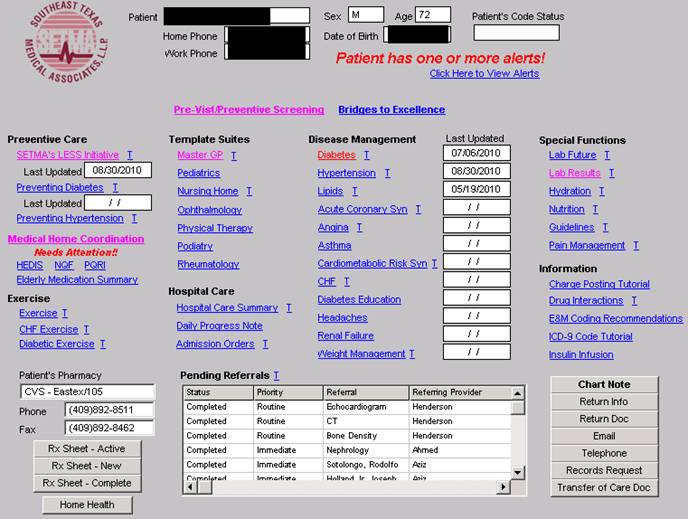
It must be remembered that there are not only two categories of patients in regard to diabetes, i.e., those who have it and those who do not, but there are two other categories. There are patients who are at high risk of diabetes and there are patients who have pre-diabetes. Pre-diabetes is a condition where a patient has progressed to a point where their ability to handle blood sugar is affected negatively and to where they have increased risk of heart disease and other complications, which, while not as severe as a patient who has diabetes, is more severe than a person who is simply at higher risk for the development of diabetes.
SETMA DPP mission is to identify these groups:
- Patients who have diabetes
- Patients who don't have diabetes
- Patients who are at high risk for diabetes
- Patients who have pre-diabetes
- Patients who, while they are not at high-risk and/or who do not have pre-diabetes, nevertheless are of an age or condition that they should be screened for diabetes.
In this context, when a healthcare provider "clicks on" the "Preventing Diabetes" title, the following template is deployed.
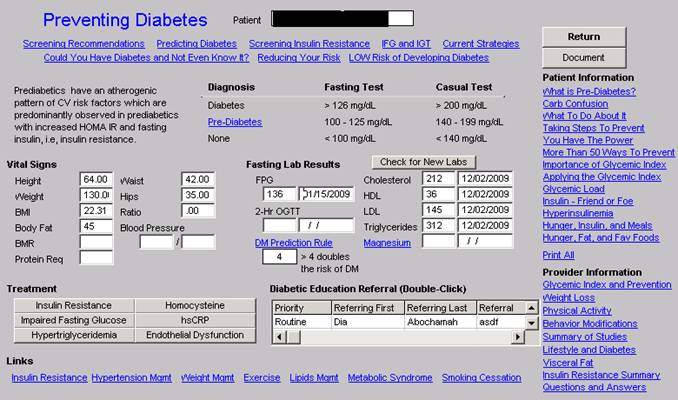
While this template appears busy, it contains a wealth of information which is valuable to your health. The following is a description of its content:
- Across the top are eight tools which are described below.
- Next there are the definitions of diabetes and of pre-diabetes. These are the standards of diagnoses which your provider will use in evaluating your status. One new standard will be added and that is if your hemoglobin A1C is 6.5% or greater on two occasions, you also have diabetes. The following is a brief summary of how diabetes is diagnosed:
- A patient has fasting blood glucose of 126 mg/dl on two separate occasions.
- A patient has a random blood glucose of 200 mg/dl or higher
- A patient has a 2-hour Glucose Tolerance Test with a two-hour blood glucose value of 200 or greater.
- A patient has a HgbA1C of 6.5% or higher on two different days.
- Your Vital signs, Fasting lab Results and your cholesterol results. The reason for this is that blood pressure and cholesterol are critical parts of the treatment of diabetes, pre-diabetes and those who are at high risk of the development of diabetes.
- Treatment of conditions associated with pre-diabetes, diabetes and those at high risk of the development of diabetes.
- Links to other patient management tools which will be used in SETMA's DPP.
- Down the right-hand side of the template are a series of education pieces which your provider can give to you, which will help you manage your health. Ask your provider to print these materials for you.
The first tool listed at the top of this screen is entitled "Screening Recommendations." When the tool is deployed it is entitled "Recommendations to Delay or Prevent Diabetes."
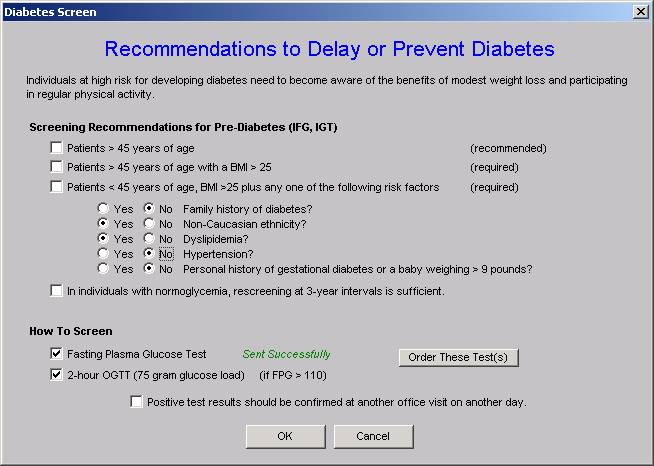
When deployed this tool automatically assesses whether screening for diabetes is "recommended" or "required." Your healthcare provider does not have to "look up" this information. The electronic health record automatically collects the results from ‚¬Ëœstructured fields" in your record and alerts the provider to check whether or not you need screening. This is the same material on the basis of which the "Preventing Diabetes" button on AAA Home is turned red or not.
If you require screening, your provider will click the button entitled "Order These Tests." At that point a message will appear asking if you have been fasting for twelve hours. If you have, the Fasting Plasma Glucose can be ordered at that time.
If the Fasting plasma glucose is between 100 and 125, you will be diagnosed with "Impaired Fasting Glucose". This is a Pre-diabetes condition and it is a more serious condition than simply having an increased risk of diabetes and requires immediate and persistent steps in order to delay the onset or to prevent the onset of diabetes.
If the 2-hour result of the 2-hour Glucose tolerance test is between 140 and 199, you will be diagnosed with "Impaired Glucose tolerance". This is also a Pre-diabetes condition and it is even more serious than Impaired Fasting Glucose. It should result in immediate and serious alterations of life style in order to delay or prevent the onset of diabetes. Those steps are weight reduction, dietary counseling and modification and a regular, consistent exercise program. Also, control of cholesterol and blood pressure should be achieved and maintained.
Predicting the Development of Diabetes in Older Adults
If you are over 65 years of age, this tool allows your provider to estimate your risk of the development of diabetes without first doing a 2-hour Glucose Tolerance Test. The details of this tool can be read on the template. Again, the content is automatically displayed. If the score is above 4, you are at higher risk of developing diabetes and preventive steps should be taken.
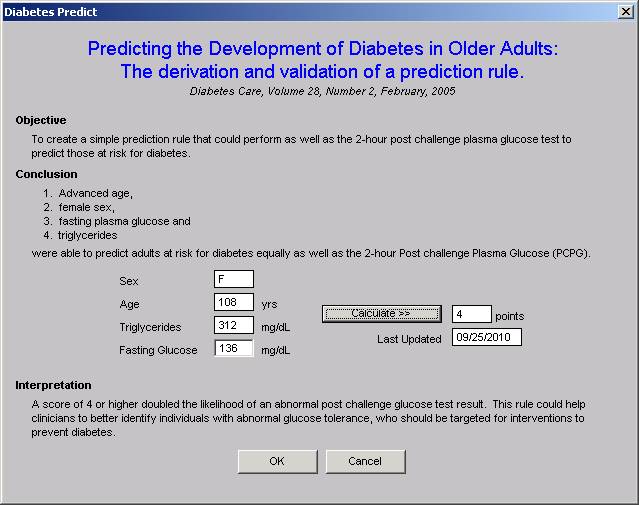
And, if your result is 4 or over, your provider will want to order a 2-hour GTT.
Screening for Insulin Resistance
The role of insulin is not commonly known. Everyone knows that it has something to do with diabetes, but what? Insulin is produced by the pancreas. It is needed by the body to regulate, along with other substances, the blood sugar level of the body. Insulin principally works by moving blood sugar into the liver and into muscles. Insulin also "signals" the liver to stop making make sugar (glucose) out of the protein and carbohydrates you have eaten. In a number of circumstances, the liver and muscles do not respond to insulin. This is called "insulin resistance," and is the precursor to type 2 diabetes.
Insulin Resistance is the first evidence of progression toward the development of type 2 diabetes. Some of the contributing cases to insulin resistance are age, genetics, obesity and a sedentary life style. In order to recognize insulin resistance and to take steps to reverse it and to prevent the development of diabetes, SETMA providers can evaluate your risk of insulin resistance. The following template does that.
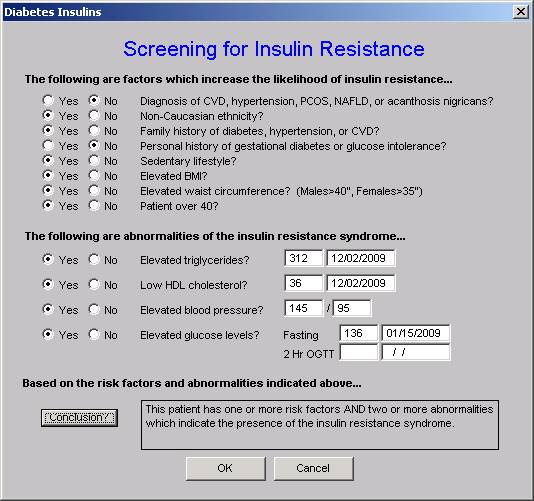
In addition, SETMA calculates several numerical scores which indicate the presence of insulin resistance; they are:
- HDL/Triglyceride ratio ‚¬€œ if this ratio is above 2, it is indicative of insulin resistance. Your SETMA provider can give you your results whenever your cholesterol is checked.
- Cardiometabolic Risk Syndrome ‚¬€œ Previously referred to as Syndrome X, Insulin Resistance Syndrome or Metabolic Syndrome, the presence of the Cardiometabolic Risk Syndrome is indicative of the presence of insulin resistance. Your SETMA provider routinely assesses the presence of this condition with standards published by both the World Health Organization and the ATP-III (Third Report of the Expert Panel on Detection, Evaluation, and Treatment of High Blood Cholesterol in Adults (Adult Treatment Panel III,.)
- HOMA-IR (Homeostasis Model Assessment of Insulin Resistance) ‚¬€œ this score is based on an equation calculated with a fasting insulin level and a fasting blood sugar. When the HOMA-IR is above 2, it is indicative of the presence of insulin resistance.
- Fasting Insulin Level ‚¬€œ when elevated insulin is present in the fasting state, it is suggestive of insulin resistance which results in increased insulin levels to compensate for the liver and muscles decreased response to insulin.
If you have insulin resistance and do not yet have diabetes, you MUST take steps to lose weight, exercise, stop smoking, reduce stress, and get proper sleep in order to delay or avoid diabetes.
IFG and IGT
One of SETMA's guides for developing electronic patient management tools is to display all of the information a provider needs in order to provide excellent care to you. This is based on our desire to make sure that a provider has access not just to what he/she knows but to what is known about a condition. And, it is based on the principle that what you absolutely must remember, you often forget, but that which you do not have to remember, you rarely forget. Therefore, we try to make all that a provider needs to know available in the electronic health record, which means that he/she will rarely if ever forget that which is important.
The definitions of Impaired Fasting Glucose (IFG) and of Impaired Glucose Tolerance (IGT) are critical to the diagnosis of Pre-diabetes and to the prevention of diabetes, thus we display them. SETMA providers don't have to remember them, therefore, they always do. The definitions of IFG and IGT and important ideas about both are presented on this template.
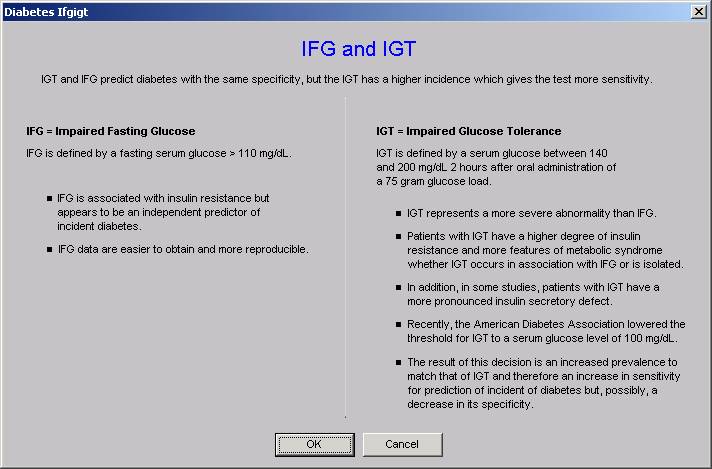
Could you have diabetes and not even know it?
With the single click of a button, your SETMA healthcare provider or nurse can give you a numerical summary of your risk of developing diabetes. If you are at high risk, then you can take steps to avoid diabetes or at least delay its onset.
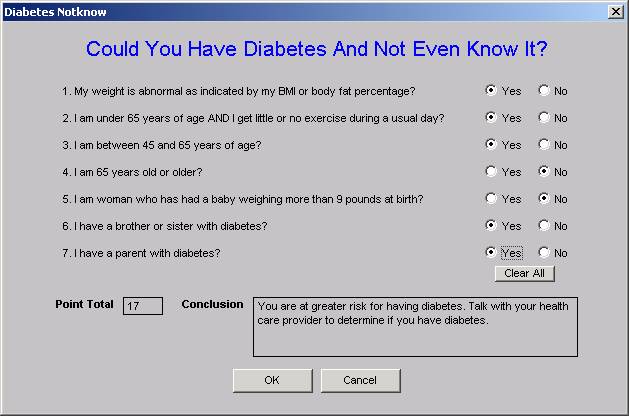
Reducing Your Risk
The following steps can help you reduce your risk of developing diabetes.
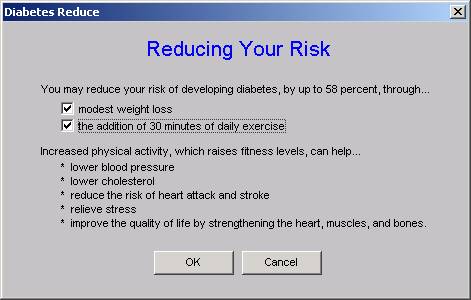
Low Risk of Developing Diabetes
The following characteristics, developed from a major study of nurses, are those of people with a very low risk of developing diabetes.
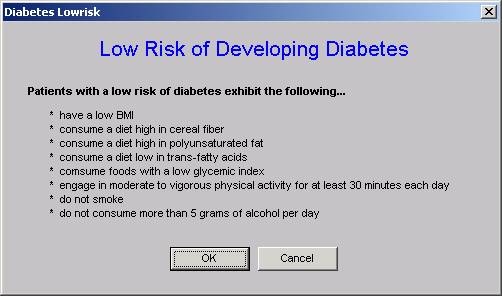
Summary
It is possible to live successfully with diabetes should you develop it; however, it is better to know your risk of developing diabetes and to take steps to delay or prevent its onset. SETMA is committed to:
- Excellent care of those with diabetes and
- Identifying those at increased risk of diabetes
- Identifying those who have pre-diabetes.
Our commit extends to teaching the later two groups how to avoid or delay the onset of diabetes.
In September, all SETMA providers had a 3 1/2 - hour training session on treating diabetes and on preventing diabetes. In September, all of SETMA's nurses had a 1 1/2 - hour training session on how to evaluate the risk of diabetes and how to prevent its onset. Ask your provider or your nurse to review your risk and if you are at higher risk and especially if you have pre-diabetes how to delay the onset or prevent the onset of diabetes.
|